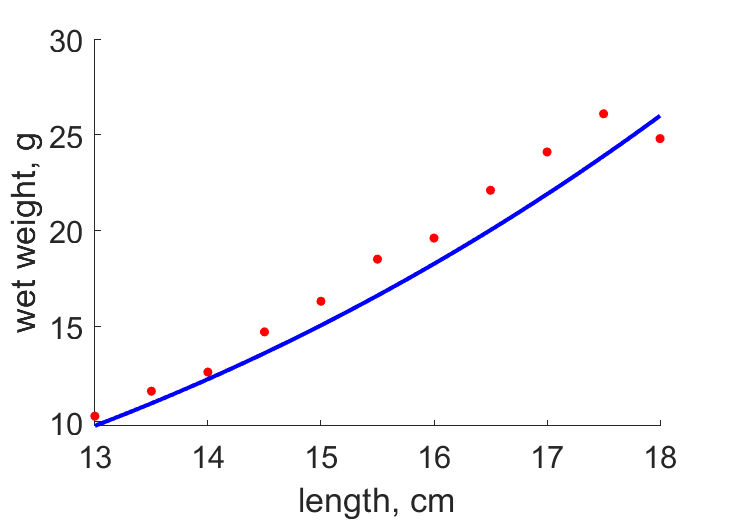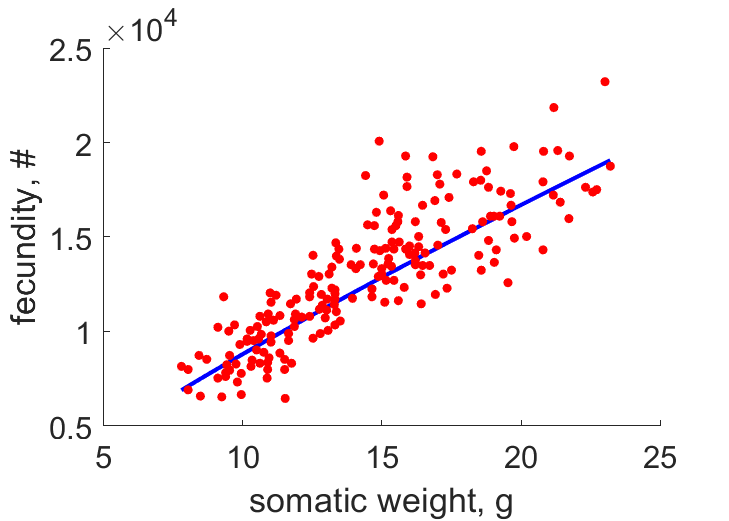Predictions & Data for this entry
| Model: std | climate: MC, ME | migrate: Ma | phylum: |
| COMPLETE = 2.5 | ecozone: MPN, MAN, MN | food: biPz | class: |
| MRE = 0.069 | habitat: 0jFr, jiMcp | gender: D | order: |
| SMSE = 0.009 | embryo: Fs | reprod: Os | family: |
Zero-variate data
| Data | Observed | Predicted | (RE) | Unit | Description | Reference |
|---|---|---|---|---|---|---|
| ab | 16 | 16.11 | (0.006991) | d | age at birth | fao |
| ap | 1278 | 1379 | (0.07971) | d | age at puberty | JohaVilh1999 |
| am | 3650 | 3659 | (0.002442) | d | life span | fishbase |
| Lb | 0.24 | 0.2366 | (0.01406) | cm | total length at birth | gma |
| Lp | 13.5 | 11.96 | (0.1138) | cm | total length at puberty | fishbase |
| Li | 23 | 24.98 | (0.08618) | cm | ultimate total length | fao |
Uni- and bivariate data
| Data | Figure | Independent variable | Dependent variable | (RE) | Reference |
|---|---|---|---|---|---|
| LN |  | length | fecundity | (0.127) | JohaVilh1999 |
| LW |  | length | wet weight | (0.07383) | JohaVilh1999 |
| WN |  | somatic weight | fecundity | (0.1128) | JohaVilh1999 |
Pseudo-data at Tref = 20°C
| Data | Generalised animal | Mallotus villosus | Unit | Description |
|---|---|---|---|---|
| v | 0.02 | 0.03198 | cm/d | energy conductance |
| p_M | 18 | 51.53 | J/d.cm^3 | vol-spec som maint |
| k_J | 0.002 | 0.002 | 1/d | maturity maint rate coefficient |
| k | 0.3 | 0.2025 | - | maintenance ratio |
| kap | 0.8 | 0.9184 | - | allocation fraction to soma |
| kap_G | 0.8 | 0.802 | - | growth efficiency |
| kap_R | 0.95 | 0.95 | - | reproduction efficiency |
Facts
- spawns in late spring and early summer (different populations) in large schools in the shoreline, or in very shallow water, to lay adhesive eggs on beaches and banks; The eggs are buried in the gravel. (Ref: fao)
- The spawning mortality of Icelandic capelin is high, especially of the males. It has been estimated that about one half of 4 year old females might on average be spawning for the second time. (Ref: JohaVilh1999)
- DEB application to this species is discussed in EinaBirn2011 (Ref: EinaBirn2011)
Bibliography